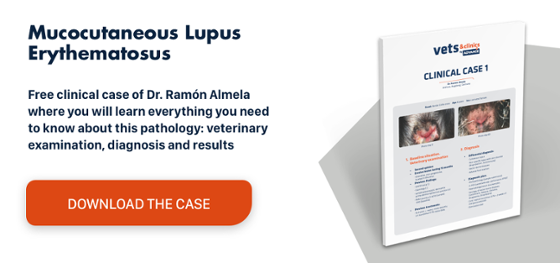Introduction
Demodectic mange or demodicosis is a skin disease caused by the excessive proliferation of different species of Demodex mites, which are common and usually harmless parasites found in small numbers in the hair follicles.1
The two species that affect dogs are Demodex canis, which causes most cases, and D. injai, a species with a longer body.2 Until recently there was also a third species with a shorter body, D. cornei, but genetic comparisons seem to indicate that it is a morphological variant of D. canis.3
In cats, demodicosis is caused by three species: D. cati, the main species causing the disease, D. gatoi, a contagious mite that inhabits the stratum corneum and whose incidence depends on the region, and a third as yet unnamed species.3,4
Presentation of demodectic mange in dogs and cats
Demodectic mange has two age-related presentations in dogs, but not in cats. Juvenile-onset demodicosis is the most common form and usually occurs in puppies and young adults (3 to 18 months).1,3Adult-onset demodicosis usually appears for the first time from the age of 4 years and is often associated with immunosuppressive diseases or treatments.3
Depending on the extent of the lesions, demodectic mange in dogs and cats can be classified as localised, coursing with a few skin lesions that normally resolve spontaneously, or generalised, with more widespread lesions that do not usually subside without acaricidal treatment.1 There is no universally accepted definition for each form in terms of the number, size and distribution of lesions.
Demodicosis in dogs is characterised by alopecia, erythema, scaling, papules, pustules, comedones and follicular cylinders that are often aggravated by secondary bacterial infections with scabs and, in the most severe cases, signs of systemic involvement.2,3 In the case of D. canis, dogs can develop pruritus if bacterial growth is present and D. injai causes excessive greasiness.
In cats, D. cati shows similar signs (erythema, hypotrichosis/alopecia, scaling and scabs with variable degrees of pruritus), while infestations with the contagious species D. gatoi is associated with pruritus on the trunk.3,4
Diagnosis
Deep skin scraping is the standard diagnostic method in most patients with suspected demodicosis. The clinician can add a drop of mineral oil to both the skin and instrument to facilitate sample collection. It is essential to squeeze the skin during the scraping to extract the mites from the follicles. Since Demodex mites are normal commensal organisms, the observation of a single mite in deep skin scrapings may be a normal, although uncommon, finding. However, the presence of more than one mite is strongly indicative of clinical demodicosis.3
Trichograms are an alternative to deep skin scrapings when the affected area is difficult to access (e.g., periocular region, interdigital spaces) or with animals that are hard to manage. A sample is obtained by pulling out a few hairs, enough to increase the sensitivity of the diagnosis, using some forceps and placing them on a slide with some mineral oil and a coverslip for examination under a microscope.3
Adhesive tape impressions, obtained by pressing the acetate tape against the skin while it is being squeezed, has also proved to be an excellent diagnostic method for canine demodicosis. Although this technique was initially described as more sensitive than deep skin scraping, subsequent studies have yielded contradictory results.3
On the other hand, a biopsy may be necessary in some breeds, such as Shar Pei (because of its special skin characteristics), or in some less common forms, such as pododemodicosis.2,3
Finally, in cases with established pyoderma, a cytology exam of the exudate obtained from pustules or drainage channels may also reveal the presence of mites.2
Treatment of demodectic mange
Although most cases of localised demodicosis, in both dogs and cats, resolve spontaneously without treatment, generalised demodicosis is a serious condition requiring long-term treatment over the course of several weeks to months.3,5
Clinical improvement should be monitored monthly and deep skin scrapings collected at each visit until two consecutive negative scrapings are obtained. Continue the treatment for 4 more weeks after the second negative skin scraping to decrease the likelihood of recurrence.3 Additionally, a 12‑month follow-up visit is recommended to finalise the clinical treatment.
Several treatments have been used for canine generalised demodicosis: amitraz baths, pipettes of imidacloprid/moxidectin, oral milbemycin oxime, subcutaneous doramectin injections and oral ivermectin.3,6-8 Ivermectin or moxidectin doses should be administered gradually to identify which animals are sensitive to the toxicity associated with these macrocyclic lactones, which is linked to the MDR1 gene mutation that is common to certain breeds, such as collies, the English sheepdog or their crossbreeds.3
Isoxazolines (fluralaner, afoxolaner, lotilaner and sarolaner) are a new class of ectoparasiticides which, since their introduction to the veterinary market to treat flea and tick infestations, have demonstrated their effectiveness in the treatment of canine demodicosis in several studies. In 2018, a multicentre, randomised field study assessed the efficacy of sarolaner compared with moxidectin/imidacloprid and concluded that the monthly oral administration of sarolaner was safe and effective in the treatment of canine generalised demodicosis.6 With regard to fluralaner, another study showed that a single topical administration managed to eliminate Demodex mites in dogs with generalised demodicosis, while topical treatment with imidacloprid/moxidectin administered 3 times every 28 days did not eliminate mites from most of the dogs treated. In addition to their efficacy, isoxazolines offer further advantages such as their ease of use and the guarantee they reach the entire body,6 making them an excellent choice for the treatment of canine demodicosis.
In cats, demodicosis can be treated with weekly baths of 2% lime sulphur or 0.0125% amitraz. A simpler alternative is the percutaneous administration of pipettes of moxidectin/imidacloprid every 7 days.3
Conclusions
Demodectic mange in dogs and cats is a disease caused by the excessive proliferation of various species of Demodex mite. It can be classified according to the age at onset (juvenile- or adult-onset) and the extent of the lesions (localised or generalised forms). The standard diagnostic method is through the collection of deep skin scrapings. Isoxazolines, a new class of drug, are proving to be an excellent option for the treatment of canine generalised demodicosis.
References
1. O’Neill D.G., Turgoose E., Church D.B., Brodbelt D.C., Hendricks A. (2020). Juvenile-onset and adult-onset demodicosis in dogs in the UK: prevalence and breed associations. . Journal of Small Animal Practice; 61(1):32-41.
2. Saló E. (2011). Formas clínicas de la demodicosis canina. No todo son alopecias. Clínica Veterinaria de Pequeños Animales; 31(2):67-75.
3. Mueller R. S., Rosenkrantz W., Bensignor, E., Karaś-Tęcza J., Paterson T., Shipstone M.A. (2020). Diagnosis and treatment of demodicosis in dogs and cats: Clinical consensus guidelines of the World Association for Veterinary Dermatology. Veterinary Dermatology; 31(1):5‐27.
4. Ortúñez A., Verde M.T., Navarro L., Real L., Vilela C. (2009). Demodicosis Felina: a propósito de tres casos clínicos. Clínica Veterinaria de Pequeños Animales; 29(3):165-171.
5. Djuric M., Milcic Matic N., Davitkov D., Glavinic U., Davitkov D., Vejnovic B., Stanimirovic Z. (2019). Efficacy of oral fluralaner for the treatment of canine generalized demodicosis: a molecular-level confirmation. Parasite Vectors; 12:270.
6. Becskei C., Cuppens O., Mahabir S.P. (2018). Efficacy and safety of sarolaner against generalized demodicosis in dogs in European countries: a non-inferiority study. Veterinary Dermatology; 29: 203-e72.
7. Perego R., Spada E., Foppa C., Proverbio D. (2019). Critically appraised topic for the most effective and safe treatment for canine generalised demodicosis. BMC Veterinary Research; 15(1):17.
8. Hutt J.C., Prior C., Shipstone M. (2015). Treatment of canine generalized demodicosis using weekly injections of doramectin: 232 cases in the USA (2002–2012). Veterinary Dermatology; 26:345-350.















